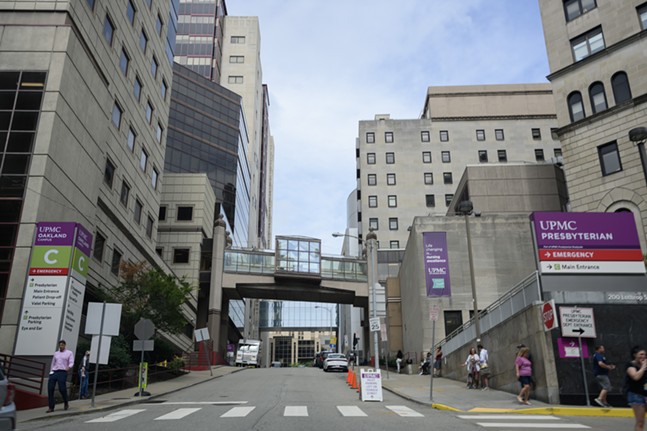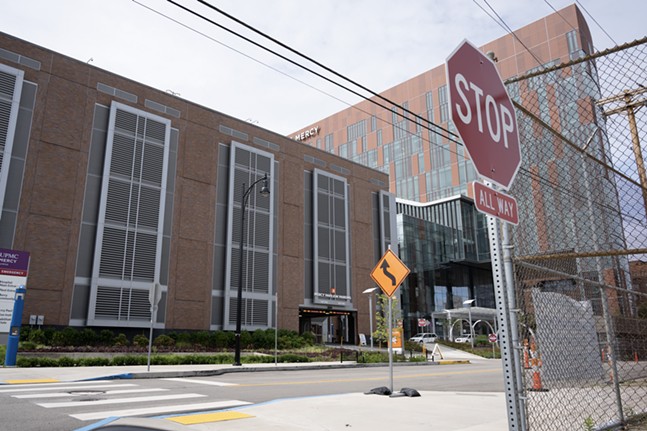UPMC is a Pittsburgh juggernaut. Its expanded Mercy Hospital and corporate headquarters loom physically above the city when you enter from Parkway West. Some 4.5 million people, including many in Greater Pittsburgh, access healthcare through UPMC insurance, and the system employed around 100,000 people in 2023.
As the nonprofit has ensconced itself in southwestern Pennsylvania, however, employees and patients say it has begun to act less like a charitable healthcare organization and more like a for-profit corporate titan.
For starters, its executives — including one who retired in 2021 — are taking home millions of dollars in pay and flying in a private jet as UPMC expands its global footprint. These same executives then brought on infamous consultant McKinsey & Co. ahead of laying off over 1,000 workers and slashing pay for travel nurses, framing these cuts as necessary to UPMC’s survival. Patients tell Pittsburgh City Paper they’ve seen a concurrent increase in fees and drop in the quality of customer service and patient care. UPMC institutions also rank near the bottom of American hospitals in terms of community investments per the Lown Institute, a nonpartisan thinktank that has published extensively on health systems’ expenditures.
Local leaders say the clear gulf between UPMC's C-suite and the workers staffing its hospitals, coupled with the nonprofit’s ongoing reluctance to pay more property taxes on its $1.7 billion in real estate, leaves UPMC looking less like a good corporate citizen and more like a Gilded Age monopoly.
City Paper spoke on and off the record with UPMC employees, patients, and local leadership to get a clearer sense of the disconnect between UPMC’s jetsetting executives and recently laid-off workers. What we found paints a picture of a nonprofit operating in a similar fashion to a for-profit company without the attendant tax burden.
CP also reached out to both UPMC and McKinsey multiple times via email and phone with detailed questions, but we have yet to receive any response from either.
Survival of the fittest
UPMC has long raised eyebrows for its high executive pay. The most recent data shows president and CEO Leslie C. Davis taking home over $10 million per year in pay. Others, including board members and highly regarded surgeons, also make salaries in the low seven figures.
CP also discovered that, since suddenly leaving UPMC in 2021, former president and CEO Jeffrey Romoff has continued to make millions off his former employer.
Romoff took home around $18 million in deferred compensation in 2023. He left in his wake a much larger hospital system overall, but Romoff also reportedly busted unions, shuttered hospitals, and engaged in controversial liver transplant practices all while giving himself six-figure raises. His deferred compensation package is millions more than what the city has sought to collect annually from UPMC — around $14 million in 2021 — in property taxes (City of Pittsburgh officials declined to comment for this story).
Alex Wallach-Hanson of Pittsburgh United, a local advocacy coalition focused on housing, economic, and environmental justice, says this top-heavy pay structure reflects a focus on profit at the expense of local investment. “UPMC continues to trend away from their history as a community-based nonprofit and towards this corporatized healthcare monopoly,” he says.
“We've gone from a city that had a tax base that was driven by extraction industry to now having a city whose tax base has been driven by property taxes,” Wallach-Hanson says. “If our two largest industries are nonprofit eds and nonprofit meds, we can't build … a thriving city without those industries paying into our tax system.”
As pay steadily increased for Romoff and others, and UPMC shelled out $37 million for marketing, the nonprofit was slow to raise its minimum wage and, headed into 2024, sought to trim back staffing levels that swelled during the worst of COVID.
To do so, UPMC enlisted McKinsey & Co., a consulting firm that has long been known for helping companies “rightsize” operations — often by laying off lower-level staff while maintaining high executive pay and investor returns. More recently, McKinsey came under fire for charging New York City $1.6 million to suggest the city use trash cans and paying out $78 million in opioid settlement money for its work with controversial OxyContin manufacturer Purdue Pharma.
Even as the hospital system moved ahead with a $1.5 billion expansion of UPMC Presbyterian in Oakland, UPMC and McKinsey were figuring out where to cut staff.
The company revealed its plans to staff earlier this year with a slideshow announcing its 2024 strategic priorities. CP was able to view the slides through an anonymous source. Framing a reduction in headcount as “tough, but necessary,” UPMC insisted it would not be cutting patient- or member-facing staff — however, the presentation lamented, an organizational restructure was needed in the face of the “strong headwinds” of a “post-pandemic marketplace.”
The slide in which this change was announced prominently features an image of Sisyphus — the mythological figure doomed to roll a boulder up a hill for all eternity. Another slide detailing UPMC’s partnership with McKinsey prominently features an image of Charles Darwin with a quote about species responding to change in order to survive.
“We are confidently going forward with approx. 1 percent less leader positions (difficult),” a subsequent slide on “Transformation” reads.
The laid-off employees CP spoke to said the announcement of cuts came as a shock given UPMC’s rapid expansion. One says that the cuts in their department had a disproportionate impact on working single mothers.
“Let's be real here: whenever it comes to jobs for women who are mothers, it is hard for us to locate employ[ers] who are willing to work around our family schedules,” this employee, who spoke on condition of anonymity to avoid retaliation, tells CP. “UPMC hit at the worst possible time.”
This person was laid off shortly after being shown the Sisyphus and Darwin slides. The former employee says UPMC obscured the true scope of layoffs by conducting them department by department and immediately bricking laid-off employees’ work-issued devices, including laptops.
“There was no humanity in it at all,” they add.
To Boca and back
In spite of promises not to cut public-facing staff, UPMC executives were laying the groundwork to do just that as they sat aboard the company’s leased Bombardier Global 6500 jet on April 23. The aircraft, which sells for $50 million and costs millions to operate and service each year, features a livery striped with UPMC’s official purple as well as a spacious interior with “revolutionary” seating.
The executives were on their way to the Boca Raton, Fla., headquarters of Omega Healthcare, which also maintains offices in the Philippines. Their business? Providing outsourced customer service for healthcare giants like UPMC in order to “accelerate cash flow” and “reduce administrative costs.” The Pittsburgh-area employees who previously answered calls from those insured through UPMC soon found themselves on the wrong end of the McKinsey-led restructuring — and replaced by Filipino workers.
In May, UPMC executives again fired up the jet, taking it to Orange County, back to Boca, and then overseas to Rome and Dublin, where UPMC maintains clinics. UPMC also maintains a clinic in Kazakhstan and announced a new Hillman Cancer Center in Croatia late last year.
Wallach-Hanson says this international expansion has coincided with the shuttering of hospitals in rural communities that are “less profitable.”
“UPMC chooses to invest their money in opening hospitals for the ultra-rich in countries around the world, while at the same time claiming a billion-dollar shortfall in their budget that they need to make up for,” says Wallach-Hanson.
Other trips included flights to Chicago and New York City. CEO Davis made several flights to and from Florida up to a year ahead of UPMC’s shifting of jobs from Greater Pittsburgh to offshore call centers and, former employees tell CP, had already been paying Omega to handle overflow calls.
Workers say they had a bad feeling about the future of their roles months before the layoffs actually hit and that morale among staff was low. They also say locals had complained about issues with offshore representatives’ ability to address concerns. The anonymous laid-off employee says that when UPMC staff raised concerns about Omega’s quality and HIPAA compliance, they were told the arrangement was here to stay.
“I can tell you right now that there is going to be an impact on patient care,” they say.
CP also spoke to patients who said they had had recent negative experiences with UPMC. Ron Kaplan is one such patient — he switched from a different primary care provider (PCP) to his wife’s UPMC PCP on her advice, but was later dismayed when he says UPMC levied facility fees that made routine blood work $160 more expensive than it had been at his old doctor.
“The service they … provided, between the examination and the blood test, were exactly the same as what I had at my previous PCP,” Kaplan tells CP.
Kaplan pressed his case with UPMC Health Plan staff but says escalation of his complaints went nowhere, and later, phone calls “seem[ed] to be farmed out” to overseas workers. Kaplan is considering switching back to his previous doctor. “I find it impossible to justify UPMC’s higher cost,” he tells CP.
“This is not going to kill us financially, but it's still a burden,” he says. “Given their resources, and given how much we're paying for insurance … it seems it's a bogus fee and went to enrich them.”
Global wealth, local poverty
It doesn’t have to be this way, locals say.
Some people CP spoke to for this story say Allegheny Health Network (AHN), UPMC’s chief rival in the region, offers one point of contrast. AHN pays its workers better, for one, and negotiated a new three-year contract including significant raises with its nurses late last year. The city has also challenged AHN’s tax-exempt status on far fewer properties than UPMC — 57 for the latter compared to six for the former.
Comparisons aside, Wallach-Hanson of Pittsburgh United says UPMC should do more to take care of local employees, especially ones who, like Romoff, have worked for the nonprofit for decades.
“We've heard of people who worked at UPMC for 40-plus years being brought into a room, told they were let go on the spot, and being walked out of the building,” Wallach-Hanson says. “And, of course, that has an impact on people's ability to afford their rent, to afford groceries.”
Local leaders and community advocates worry that allowing UPMC to continue cutting staff while pouring money into an expanding network of hospitals worldwide essentially gives the company carte blanche to behave as a megacorporation — while continuing to avoid paying local taxes.
“A city like Pittsburgh is not going to thrive if our fastest and largest growing industries aren't contributing money into our tax base,” Wallach-Hanson says. “It really raises the question of, should UPMC continue to get their nonprofit tax status if they're going to continue to prioritize CEO compensation, investing in countries around the world, and not investing in care for people in Pittsburgh?”






















